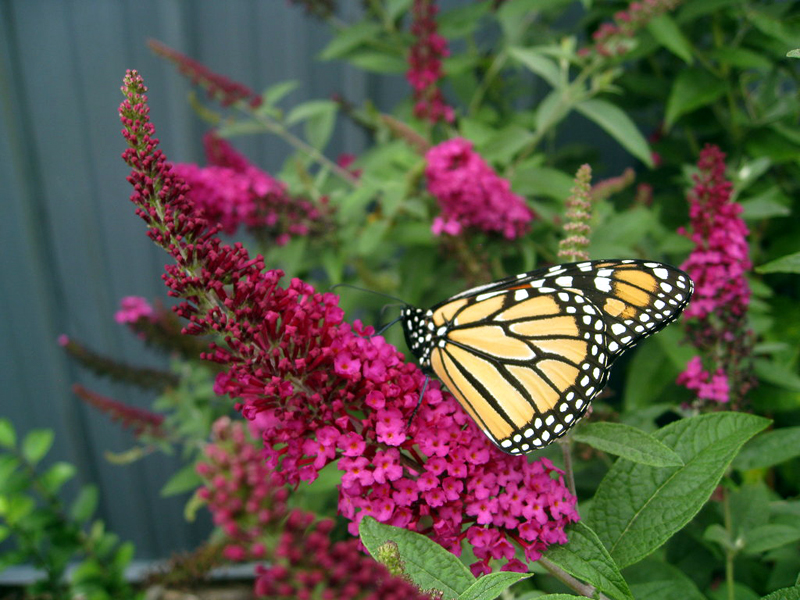From watering tips to advice about removing invasive types, gardening experts share their insight.

By Caroline Biggs, Martha Stewart
If you're searching for a colorful, long-lasting shrub for your garden, consider planting buddleia. "Commonly known as 'butterfly bush,' buddleia can grow up to seven feet tall and ranges in color from light pink to dark purple and blues," says Sabine H. Schoenberg, host of "Sabines New House" on Smart Healthy Green Living. "The height makes these a great screen for summer privacy and color, while the blooms are great for attracting pollinators to your yard."
Along with attracting butterflies and bees to your garden, buddleia is easy to grow and, if properly cared for, comes back year after year. "Buddleia is a very durable plant that tolerates less than ideal conditions," gardening expert Melinda Myers explains. "Once established, they can tolerate heat and humidity, and in some cases, drought. However, certain cultivars are considered invasive, so it's important to make sure you plant the appropriate type for your region."
How to Plant Buddleia
According to Myers, buddleia should be planted so that the crown of the shrub (the place where stems connect to the roots) is at the surface of the soil. "Loosen or cut any girdling roots you discover before planting," she says. "Dig the hole with a width of at least two times the diameter of the rootball, and at the same depth, being careful not to go too deep." Additionally, Schoenberg says it's essential to plant your butterfly bush in an area that receives full sun. "Buddleia needs at least six hours of sun a day, but the more the better."When to Water
If you are watering your buddleia every day or two, Myers says you're overdoing it. "Water thoroughly to moisten the soil to the depth of the rootball, which will encourage the roots to expand beyond the planting hole," she says. "For heavy soils, in areas where temperatures are neither extremely hot nor cold, water once a week, but in fast-drying soils, water every four days or so. Check the top few inches of the soil and water when it is crumbly and slightly moist, and then gradually cut back to encourage deep and more drought-tolerant roots."Mulch Matters
A little mulch goes a long way in supporting the growth of your buddleia. "Mulch helps the plants retain moisture in the summer and protects them against cold temperatures during the winter," Schoenberg says. "A good rule is to spread a little mulch in spring." Along with safeguarding your buddleia from weather extremities, Myers says that organic mulches can help prevent the spread of weeds. "They also reduce competition from grass, which can compete with buddleia for water and nutrients and slow down plant growth."Don't Plant Invasive Types of Buddleia
Since certain types of butterfly bush are considered invasive species, Myers says it's crucial to double check that you're planting a cultivar that is deemed safe for your region. "Some states, like Washington and Oregon, have banned invasive cultivars altogether," she explains. "However, there are many non-invasive types that have been introduced as an alternative for gardeners in areas where only sterile ones are allowed—so always look for this feature when buying buddleia."How to Remove Buddleia
If you discover you've planted an invasive type of buddleia, Amy Enfield, a horticulturist at Bonnie Plants, says there are a few ways to remove it from your garden. "The most sure-fire way to eliminate the plant is to treat it with an herbicide labeled for control of tough brush," she says. "If you catch the invasive buddleia before the flowers set seed, you can cut back the plant to remove all the flowers and dig up the root system. Just be sure to bag up and discard any clippings since they could take root in the soil if left behind."
Everything You Need to Know About Buddleia, Also Known as Butterfly Bush
![[feature] Everything You Need to Know About Buddleia, Also Known as Butterfly Bush](https://blogger.googleusercontent.com/img/b/R29vZ2xl/AVvXsEgf80KcqbbbdmPRC5BXNSi0tlQVSs9cQMUMF6W2K5WRVd9cO_p-g1eURuCmLgVJgNCaUV_a8Uv5XXDQXV4vV3lw1vcy2F0OOj6N2NGRSwEyu0PIbuyCeNRPLYyyWtt05l8BSfBxkiF_5NkA/s1600/autos.dearjulius.com.jpg) |
| © Getty / Jacky Parker Photography |























